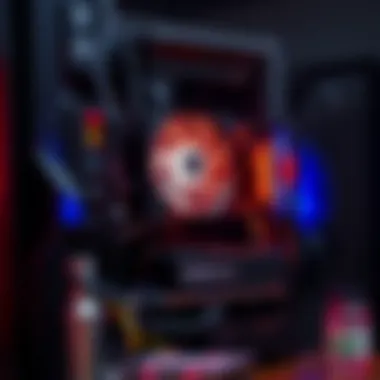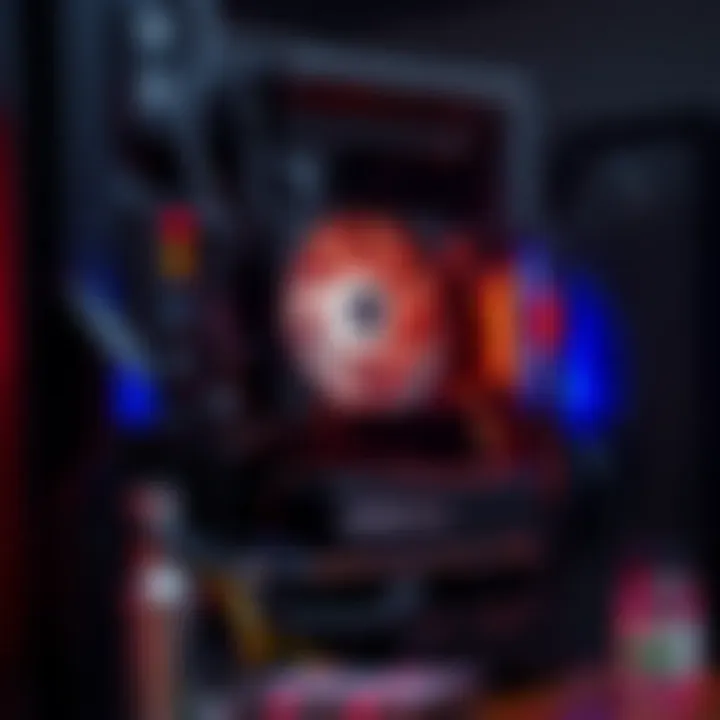Building a GPU Mining Rig: A Complete Guide


Intro
Diving into cryptocurrency mining opens up a world of opportunities, and one of the most popular methods today is through GPU mining rigs. The allure of owning a piece of the digital currency pie has adults and tech enthusiasts buzzing. Yet, building a GPU mining rig isn't merely about stacking some graphics cards and pressing a button. There's an art to it; an intricate dance of hardware, software, and power management.
In this guide, readers will embark on a journey through the essentials needed to construct a GPU mining rig. From understanding what components are necessary, to grasping the optimization techniques that lead to increased efficiency, this comprehensive piece provides both beginners and experienced miners with the knowledge they need.
It's not just about assembling machinery—it's about understanding the underlying principles of the cryptocurrency ecosystem and how to make the most of your investment. By the end of this guide, you will possess a well-rounded understanding of GPU mining, ensuring that you're not just building a rig, but building a solid foundation for your mining endeavors.
Understanding GPU Mining
The realm of cryptocurrency mining can seem like a daunting labyrinth, but grasping the fundamentals of GPU mining is crucial for anyone looking to dive deeper into this space. At its core, GPU mining involves the use of Graphics Processing Units to solve complex mathematical problems that confirm transactions on a blockchain. Mastering this topic enables enthusiasts to optimize their mining efforts, increase profitability, and understand the technical intricacies that drive the crypto market.
The Basics of Cryptocurrency Mining
Cryptocurrency mining isn’t just about accumulating virtual coins; it's a concerted effort to maintain the integrity of a decentralized network. When a transaction occurs, it must be validated by miners. They compete to solve equations linked to those transactions, and the first one to solve it adds a block to the blockchain—thus earning a reward in the form of cryptocurrency.
This process requires significant computational power, which is where GPUs come in. Unlike CPUs, which are more versatile but less efficient for parallel tasks, GPUs are designed to handle multiple operations simultaneously, making them ideal for the repetitive calculations required in mining.
In practical terms, when setting out to mine cryptocurrency, a miner must first select a coin that is feasible to mine with the chosen hardware. Some coins are easier to mine than others, and not all require the same levels of resources. Additionally, it's wise to stay informed about the current market dynamics, as they have a direct impact on the potential profitability of mining endeavors.
Importance of GPU in Mining
The role of the GPU in mining can hardly be overstated. Unlike traditional CPUs, which can struggle with the vast computational requirements of blockchain verification, GPUs excel in running parallel processes. This efficiency translates into higher hash rates—the speed at which a mining rig can perform hashes or calculations.
- Higher Processing Power: A single high-performance GPU can outperform several CPU cores when it comes to the intricate calculations needed for mining. This means that a rig with multiple GPUs can significantly enhance mining capabilities.
- Cost-Effectiveness: While the initial outlay for quality GPUs can be substantial, the long-term returns often justify the expenditure. Efficiency in energy use means that miners can recoup their investment over time, especially during bullish market phases.
- Flexibility Across Different Currencies: Different cryptocurrencies adopt various hashing algorithms. GPUs provide the versatility needed to switch between coins, enabling miners to chase the most lucrative options available.
"A well-thought-out GPU mining setup can withstand market fluctuations better than single-CPU setups—making it a strategic investment for long-term sustainability."
Understanding these factors equips investors, analysts, and developers with clear insight into why GPU mining stands out in the cryptosphere. It’s not merely about a financial investment; it’s about harnessing technology effectively to work in favors of your goals.
By delving into the basics and recognizing the pivotal role of GPUs, readers position themselves not just as participants in mining but as knowledgeable players in the evolving landscape of cryptocurrency.
Selecting the Right Components
When it comes to constructing a GPU mining rig, selecting the right components is paramount. The components largely determine not just the performance but also the longevity and efficiency of the rig. Choose wisely, and you may find that your investment pays off handsomely in the volatile world of cryptocurrency. Conversely, skimping on careful selection can lead to costly inefficiencies or even total system failures. Let’s delve deeper into each critical component, starting with the heart of the rig: the Graphics Processing Units.
Graphics Processing Units
Comparing Different GPU Models
Looking into GPU models is vital. Each model has its own strengths and weaknesses. For any mining rig, the right GPU can significantly affect performance and energy efficiency. Key considerations should include clock speeds, memory size, and architecture. For instance, models like the Nvidia GeForce RTX 3080 are known for their strong hash rates and energy efficiency, while AMD’s Radeon RX 6800 XT is often favored for its memory bandwidth.
The crucial characteristic here is performance per watt; you want the most hashing power with the least energy draw. The trade-off might include price—sometimes higher cost reflects superior long-term returns.
Evaluating Hash Rates
Hash rates are an essential metric in mining. Essentially, it reflects how many hashes a GPU can compute per second. The importance of hash rates cannot be overstated as they directly correlate with the potential mining earnings. For example, a GPU with a hash rate of 50 MH/s will be able to process and validate transactions quicker than a 30 MH/s model.
However, it’s important to balance hash rates with energy consumption. A GPU that offers high hash rates but drains energy like a leaky faucet could lead you down a path of diminishing returns. Finding that sweet spot between efficiency and power is key.
Cost Efficiency Considerations
Cost efficiency should be a prominent lens through which one evaluates their GPU choices. It’s not just about the initial purchase price; long-term operational costs, including electricity and cooling, need to be factored in. Using tools like cost-per-MH/s can greatly aid in making informed decisions.
Moreover, consider resale value. Some GPUs lose value quicker than others, potentially affecting your overall return on investment. A GPU option might appear cheap upfront but could cost you down the line in added electricity bills, heat generation, and cooling expenses.
Motherboard Specifications
Supported GPU Slots
Motherboard specs can often take a backseat in conversations about building mining rigs, but in reality, they are the backbone that supports how many GPUs you can run. Not all motherboards are created equal. Some support multiple GPUs efficiently, while others do not. Look for motherboards that come with ample PCIe slots to accommodate your GPU setup, as well as compatibility with crossfire or SLi technologies.
The number of supported GPU slots indicates the potential scalability of your rig. If you think you’d want to scale up, it’s prudent to invest now in a board that can handle future GPUs.
Chipsets and Connectivity
The chipset of the motherboard plays a crucial role in determining overall performance. A reliable chipset ensures that data transfers between the CPU and GPUs are efficient. This means choosing boards with robust chipsets that facilitate seamless communication.
Additionally, connections for additional peripherals and improvements, such as better cooling solutions or even extra storage, are often overlooked but can greatly improve the mining operation's effectiveness. Future-proofing with good chipsets will save you headaches later on.
Power Supply Requirements
Calculating Wattage Needs
Determining the wattage required for your mining rig is foundational. If you select a power supply that is too weak for your setup, you’ll risk stability and efficiency. A general rule of thumb is to add up the wattage requirements of all components and then add an extra 20% to 30% to account for any spikes. This prevents the PSU from running at maximum capacity, thus prolonging its lifespan.


Different components have varied power requirements, and those can fluctuate during usage. Therefore, ensuring reliability is key to continuous operation.
Selecting PLUS Certified Units
Choosing an 80 PLUS Certified power supply is an excellent consideration. The certification means that your PSU operates at a minimum efficiency level, reducing wasted energy, which can translate into lower electricity bills over the long haul. This isn’t just beneficial; it's essential for a mining rig that often runs 24/7.
Make sure to look for higher certification like Gold or Platinum if you're serious about keeping your operational costs in check. Not only do these units save money, they also generate less heat, which can be advantageous for your cooling solutions.
Cooling Solutions
AIR vs LIQUID Cooling
Cooling solutions are an often overlooked but critical aspect of a mining rig's architecture. Two primary options to consider are air and liquid cooling. Air cooling is typically cheaper and easier to set up; however, it can lead to higher temperatures if not managed correctly. On the other side, liquid cooling tends to be more efficient at managing heat but comes with higher installation complexity and cost.
Evaluating your specific scenario—taking into consideration the number of GPUs, their heat output, and your budget—will help you make this decision wisely.
Efficient Ventilation Design
Having an efficient ventilation design is essential in maintaining optimal temperatures across all components. The airflow in a case should promote a uniform distribution of cool air while removing warm air effectively. Investing in quality fans, ensuring proper placement, and possibly even adding filters can dramatically influence cooling outcomes, potentially extending the lifespan of your GPUs and other components.
Creating been thought-out ventilation can reduce the frequency and intensity of overheating, added noise levels, and countless inconveniences in your mining endeavors.
By carefully selecting the components and addressing each of these aspects, you can build a system that stands the test of time while delivering respectable performance in the mining landscape.
Assembling the Rig
Building a GPU mining rig is akin to constructing a finely tuned machine, where each piece plays a critical role in the grand scheme of cryptocurrency mining. The assembly process is where the theoretical converts into practical, and understanding this part of rig development is pivotal. It’s not just about fitting components together; it’s about ensuring functionality, optimizing performance, and establishing a solid foundation for mining activities.
When you assemble the rig, you bring together the previously selected components: from the motherboard to the GPUs, power supply, and cooling mechanisms. Each element must be integrated seamlessly to create a powerful mining unit. The benefits are obvious: a well-assembled rig can enhance mining efficiency, reduce risks of overheating, and maintain stability during prolonged operations, ultimately resulting in better profits.
Step-by-Step Assembly Process
The assembly of a GPU mining rig involves several key steps, all of which are crucial for its proper functioning and performance. Let’s take a deeper look into each part of this process.
Connecting the Motherboard and GPU
The connection between the motherboard and GPU is the lifeline of your rig. This is where the GPU communicates with the primary unit, handling all the heavy lifting associated with cryptocurrency computations. Ensuring that this connection is robust can mean the difference between a rig that performs well and one that lags.
A critical characteristic here is the motherboard's PCIe slots—these are narrow slots that hold the GPUs in place. Using a motherboard with sufficient PCIe lanes is crucial; it allows for multiple GPUs to be connected simultaneously, which is the bread and butter of successful mining setups. The efficiency in this regard is significant, primarily because it maximizes performance without breaking the bank on additional components.
One unique advantage to consider is the type of risers used for the GPU connections. Using PCIe risers can allow for better airflow and positioning of the GPUs, optimizing cooling solutions while maximizing hash rates. However, it’s vital to ensure that these risers are compatible with your selected components to prevent connectivity issues.
Installing Power Supply
The power supply is like the heart of your mining rig, pumping energy to all components. A right selection of a power supply unit (PSU) not only fuels the rig but also enhances its operational safety. It’s critical here to choose a reliable PSU that has enough wattage to support all your GPUs, ensuring that no hiccups in power occur during mining sessions.
A key characteristic of installing power supplies is the emphasis on 80 PLUS certification. This certification indicates higher energy efficiency, which can save costs on your electricity bills in the long run. A shady power supply can lead to inefficiency and potentially shorten the lifespan of your components.
With regards to innovative features, many modern power supplies include modular cables, allowing for a cleaner setup and improved airflow within the case. However, the downside might be the higher initial cost when compared to traditional non-modular units. It’s a trade-off between aesthetics and functionality versus cost that each builder should consider.
Setting Up Cooling Mechanisms
In the realm of GPU mining, heat is your sworn enemy. When building your rig, how you set up your cooling mechanisms can significantly affect performance levels and the lifespan of your GPUs. Different strategies can be employed, from air cooling to liquid cooling, each with its pros and cons.
The key characteristic of air cooling systems lies in their simplicity and cost-effectiveness. Using fans to circulate air within the mining rig can be adequate, especially for those just starting or on a tighter budget. But be wary, as over time, dust can accumulate, leading to potential overheating issues.
On the other hand, liquid cooling presents a more sophisticated approach. This method can keep temperatures lower and provide enhanced performance, however, it also comes with increased complexity and cost. Installation of liquid cooling systems often requires more maintenance and precaution to avoid leaks.
In terms of unique features, the design of your case also plays a role in cooling effectiveness. A well-ventilated case can serve as a passive cooling mechanism, whereas cramped spaces can lead to overheating. Deciding on the cooling solution ultimately hinges on budget, size considerations, and personal preference.
Software Installation
Once the physical components are in place, the next phase is software installation. This is another vital section of building a GPU mining rig, enabling the various parts to work together seamlessly. A well-chosen software will streamline mining processes and optimize the performance of the rig itself.
Choosing the Right Mining Software
Selecting the appropriate mining software is instrumental. This software helps direct the function of the mining rig, interfaces with the blockchain, and connects miners to mining pools. Each mining software can come with different features and usability options.
The right software can significantly improve your rig's hash rate, directly impacting profitability. Popular choices include CGMiner and Ethminer, each tailored for specific mining operations. What makes these options stand out is their flexibility; they support multiple hardware variants and come with customizable settings.
One unique feature of some mining software is the ability to employ auto-tuning settings, which can adjust performance according to real-time data, ensuring efficiency. However, the user must be cautious, as improper configuration can lead to suboptimal performance.
Configuring Mining Settings
Configuring the mining settings is your chance to tailor the rig to suit your specific mining ambitions. This will determine how the hardware interacts with the mining pool and the blockchain. Setting optimal parameters can boost efficiency significantly.
A key aspect of configuration addresses parameters such as overclocking and power allocation. By modifying these settings, users can often achieve higher hash rates, enhancing their mining capabilities. The advantage of fine-tuning lies in its potential to extend the profitability of the operation, especially in environments of fluctuating cryptocurrency prices.


However, it’s critical to balance performance with stability to avoid damage to your components. Overclocking can lead to increased wear and potential failure down the line, recognizing this balance is imperatively beneficial.
Building a mining rig is a blend of art and science, with the assembly and software stages laying the groundwork for a successful operation and maximized returns.
This phase of assembling and configuring a GPU mining rig is where the ambitions of mining enthusiasts come to life. Each step impacts the rig's overall function, aiming towards an efficient, powerful, and profitable mining operation.
Monitoring and Optimization
Monitoring and optimization are critical pieces of the puzzle when it comes to GPU mining. The crypto landscape changes faster than a cat on a hot tin roof, and staying aware of how your rig is running is vital. A well-optimized rig can mean the difference between profiting and just scratching by. When miners keep an eye on performance metrics, they can fine-tune their setups, ensuring that everything runs as smoothly as a new pair of roller skates. This section will dive into various tools and techniques that assist in monitoring and optimizing your mining rig to ensure you extract every bit of performance available.
Performance Tracking Tools
Performance tracking tools act like a watchful guardian for your mining rig. They provide invaluable data, enabling miners to make informed decisions regarding efficiency and potential upgrades. Below are two pivotal tools for this monitoring process.
Real-time Monitoring Applications
Real-time monitoring applications are the backbone of effective mining. These handy tools provide a live feed of your rig’s performance, letting you see everything from temperature readings to hash rates without breaking a sweat. Their key characteristic is their ability to deliver instantaneous data, which is crucial for miners who need to detect performance drops swiftly. For example, programs like MSI Afterburner or HWMonitor allow users to track various metrics, ensuring that nothing's amiss.
"Having real-time monitoring is like having a second brain - you know what's going on without diving deep into complicated setups."
One unique feature of these applications is alert systems. They can notify you if temperatures soar too high or if a GPU's performance drops unexpectedly, helping you avoid costly hardware failures. However, the downside is that if not configured correctly, notifications might become more of a nuisance than a blessing. Luckily, tweaking settings usually fixes that.
Utilizing Hash Rate Calculators
Utilizing hash rate calculators is another smart move in the optimized mining world. These calculators help potential and current miners estimate their expected earnings based on their rig's hash rate, power consumption, and current market conditions. Their prominent characteristic lies in their ability to analyze and predict profitability based on real-time variables.
A site's standout feature is its ability to update calculations in real-time as market conditions shift. By plugging in your rig's details, miners can gauge whether it's worth it to persist with their current setup or consider upgrades. It’s a tool that’s often favored because it provides easily digestible forecasts and can influence investment decisions. Yet, its accuracy can oscillate with market volatility, meaning that while it’s useful, it shouldn't be the sole tool in a miner's belt.
Fine-Tuning Settings for Efficiency
Fine-tuning settings is akin to putting the final polish on a masterpiece. Getting the most out of your mining rig requires attention and adjustments to the system’s configurations. With the right tweaks, miners can maximize hash rates while reducing power consumption, leading to greater profitability.
Overclocking Techniques
Overclocking techniques are popular in the mining community for a good reason. This process allows miners to push their GPUs beyond standard operating frequencies, enhancing performance. Notably, overclocking can significantly increase hash rates, pushing your mining capabilities into overdrive.
One key characteristic of overclocking is its balance between performance boosts and thermal output. If done correctly, miners can extract more productivity from their rigs, turning non-productive hours into profit. Perhaps the most compelling feature is the capability to tweak individual settings depending on specific workloads. However, one must tread carefully. Overclocking can lead to overheating if proper cooling solutions aren't in place.
Adjusting Power Draw
Adjusting power draw is a straightforward yet critical aspect of mining efficiency. This process involves setting limits on power consumption to ensure that electricity costs don’t eat into profits. The key here is the balance; finding a sweet spot where your rig runs effectively without drawing excessive wattage can lead to meaningful savings.
A significant characteristic of this approach is its flexibility. Power limits can usually be changed on-the-fly depending on market conditions or mining jobs. You can push your rig a bit harder or ease off if electricity prices spike. One of the unique features is using software tools that allow for precise adjustments without shutting down your rig, adding an extra layer of convenience. However, getting too aggressive in power management can lead to reduced performance, so finding that ideal mix is paramount.
Cost Analysis and Profitability
When it comes to building a GPU mining rig, understanding the balance between initial investment and potential profitability can make or break your venture. This segment dives deep into the financial dynamics of GPU mining, a facet that often gets overshadowed by hardware specs and setup tips. By assessing your costs—both upfront and ongoing—you can make informed decisions that drastically influence your return on investment (ROI).
Initial Setup Costs
Starting off, the initial setup costs encompass all the essential expenditures required to get your mining rig operational. This includes the components you select, tools for assembly, and any additional resources like cooling systems or surge protectors. Knowing your budget is crucial; it sets the groundwork for calculating how much you need to mine to recoup your investment.
Each component comes with varying prices depending on brand, efficiency, and technology. For instance, if you opt for high-end GPUs like the Nvidia GeForce RTX 3080 or AMD Radeon RX 6800 XT, you may find yourself spending a hefty sum. However, these GPUs generally provide higher hash rates, potentially yielding faster returns. Thus, it’s essential to strike a balance between performance and cost. Ultimately, assessing your initial setup costs helps you establish a clearer financial picture before you plunge into the mining business.
Operating Costs
Electricity Consumption
Electricity consumption is a major player in your ongoing expenses. Mining consumes substantial power, and understanding how much your rig will use is vital for budgeting purposes. GPUs can draw anywhere from 200 to 350 watts depending on the model and the workload. With fluctuating electricity rates, estimating this cost can be tricky.
Key characteristic: The sweet spot of energy efficiency is often found in mid-range GPUs, which may consume less power while still delivering competitive hash rates. Choosing GPUs with positive reviews on power efficiency helps reduce your electricity costs over time.
However, the downside is that significant energy use can lead to heightened electricity bills, especially during long mining hours. Hence, scrutinizing your mining setup for energy efficiency is not just beneficial; it’s imperative. Keeping track of your energy consumption can save you money in the long run while optimizing your mining operation.
Maintenance Expenses
Maintenance expenses might not be the first thing on your mind when planning a mining rig, but they can accrue significantly over time. Components may overheat or wear out, leading to replacement costs or repairs. Regular maintenance includes cleaning dust from GPUs and fans, checking power connectors, and ensuring proper airflow.
Key characteristic: The more you invest in high-quality hardware, the less often you will need repairs. High-performance GPUs tend to have longer lifespans if well maintained. However, they also require periodic updates to software and firmware to ensure optimal performance, which adds another layer of costs. The unique feature here is that while initial costs for high-end gear may be steep, they can lead to lower maintenance expenses and a more efficient operation over time.
Break-even Analysis
Calculating Returns
Calculating returns from your mining investment involves figuring out how much crypto you earn relative to your setup and operating costs. Various tools and calculators can help you analyze your expected returns based on hash rate, electricity costs, and the current value of the cryptocurrencies you're mining. A common method is to use a straightforward ROI calculator, which factors in all relevant costs.


Key characteristic: Quickly determining how long it will take to break even is essential for understanding the viability of your mining rig. If your returns don’t align with your expectations, you might need to reassess your strategy or hardware choices.
The challenge lies in the volatility of the crypto market. High returns today can quickly diminish if market prices fluctuate. Your investment could pay off in just months or take years, depending on market movements.
Market Volatility Factors
Market volatility is one of the cornerstones of cryptocurrency investment and indubitably influences mining profitability. Factors include regulatory news, market sentiments, and technological advancements. For example, when Bitcoin hits a high, miners' profits can surge, but negative regulatory news may swiftly alter that scenario.
Key characteristic: Being attuned to market trends arms miners with the knowledge to adapt their strategies. Whether choosing to mine specific altcoins or holding onto their mined cryptocurrencies, those who grow adept at reading market indicators can substantially boost their profitability.
However, the downside of market volatility is that it can lead to abrupt financial losses if not navigated wisely. Setting realistic expectations and preparing for fluctuations mitigates these risks, allowing for proactive rather than reactive strategies. Ultimately, the financial health of your mining rig significantly depends on your ability to manage both initial investments and ongoing costs thoughtfully.
Legal and Environmental Considerations
As GPU mining continues to evolve, it brings forth not just technological challenges but also legal and environmental implications. Understanding these aspects becomes vital for anyone considering a dive into cryptocurrency mining. This section sheds light on the importance of compliance with local regulations, the environmental impact of mining, and explores steps to mitigate negative effects. Keeping abreast of legal guidelines ensures a smoother operation and minimizes disruptions in future growth or profitability.
Regulatory Compliance
Understanding Local Laws
When tapping into the world of GPU mining, comprehending local laws is not just a nice-to-have; it's a cornerstone of responsible mining. Different jurisdictions have varying regulations that can impact how you operate your mining rig. Local laws dictate zoning, taxation, and even electricity usage regulations, which are crucial for long-term viability in the mining business.
For example, some regions may impose strict limitations on electricity consumption or impose taxes on mining profits. Adhering to these laws can prevent hefty fines and operational shutdowns, giving miners a more secure foothold in the industry. Furthermore, understanding local laws also opens up avenues for potential financial incentives from governments keen on encouraging tech innovation, thus making it a beneficial step for any miner.
Licenses and Permits
Licenses and permits required to run a mining operation vary widely depending on location, and securing them is essential. Some areas might demand specific permits to operate a business from your residence or require a mining license if you cross certain revenue thresholds. Engaging with your local government can clarify what permits are necessary.
The key characteristic of licenses and permits is that they help legitimize your business, making it easier to seek loans or investments down the line. While obtaining these can feel like navigating a bureaucratic maze, skipping this step might lead to unwelcome trouble. Thus, securing the necessary documentation not only aligns with legal expectations but can serve as a solid foundation for building a reputable venture in the crypto mining realm.
Environmental Impact
Carbon Footprint of Mining
People are rightly concerned about the environmental consequences of cryptocurrency mining. One significant aspect is the carbon footprint generated during operations. Power-hungry mining rigs require substantial energy consumption, which often translates to higher carbon emissions, especially in regions reliant on fossil fuels.
Understanding the carbon footprint of mining is crucial for assessing your operation's sustainability. Many miners might be unaware that their actions contribute to broader environmental issues, such as climate change. Hence, adopting greener practices, whether it's using energy-efficient hardware or opting for renewable energy sources, can help mitigate this impact while appealing to eco-conscious investors.
Efforts for Sustainability
As awareness grows regarding the environmental toll of GPU mining, various efforts are being made to create more sustainable practices. Some miners engage in partnerships with renewable energy companies to source eco-friendly electricity, while others incorporate energy-efficient components into their setups. Efforts to reduce waste and improve recycling of older components are also gaining traction.
What’s noteworthy is that sustainability isn't just about reducing harm; it can also enhance your mining operation's profitability over time. By lowering energy costs and gaining a more positive public perception, miners can attract a wider audience and potentially benefit from government incentives aimed at promoting sustainable practices. However, the initial investment in green technologies may vary, making it essential to analyze costs and returns on such sustainable initiatives.
Adopting responsible mining not only protects the environment but also paves the way for a more resilient and profitable future in cryptocurrency mining.
Overall, navigating the legal rules and environmental repercussions is not merely a box-ticking exercise but essential for any serious miner aiming for longevity and success in the complex world of cryptocurrency.
Future Trends in GPU Mining
As the cryptocurrency landscape continues to evolve, understanding future trends in GPU mining is crucial for anyone thinking about investing in or building a mining rig. These trends provide valuable insight into what technologies and strategies may dominate the market, and can help miners make informed decisions as competition heats up and innovations unfold. Keeping an eye on these aspects can significantly enhance the performance and profitability of mining operations.
Emerging Technologies
Advancements in GPU Architecture
The field of GPU architecture is witnessing rapid innovations aimed at increasing both efficiency and performance. A key characteristic of recent advancements is the shift towards architectures that prioritize parallel processing capabilities. This is especially beneficial in mining, where multiple calculations must be carried out simultaneously. For instance, newer models from manufacturers like NVIDIA and AMD are incorporating tensor cores and other specialized components, enabling miners to tackle complex algorithms with greater speed.
One unique feature of these advanced architectures is their ability to dynamically adjust power consumption based on workload. This means they can operate at maximum efficiency without unnecessarily drawing power when less computation is required. The big advantage here is the potential for reduced electricity costs while maintaining high hash rates, which is a crucial factor for profitability in mining operations.
However, the upfront costs for these advanced GPUs may pose a barrier for entry-level miners. Additionally, as newer architectures emerge, older models may depreciate faster, affecting their market value.
Alternative Mining Algorithms
As mining becomes more competitive, miners are beginning to explore alternative mining algorithms beyond the traditional proof-of-work model. These algorithms, such as proof-of-stake or delegated proof-of-stake, can significantly lower energy consumption, thus addressing some environmental concerns associated with cryptocurrency mining. The key characteristic of these approaches is that they often require far less computational power, allowing miners to use less expensive and less powerful equipment.
One unique feature here is the flexibility of switching algorithms according to market conditions or changes in network consensus rules. This adaptability can provide an edge over miners who are locked into specific protocols. While the benefits are clear, drawbacks include the need for continuous research to stay abreast of rapidly evolving technologies and potential regulatory implications tied to the algorithms being used.
Market Predictions
Analysis of Crypto Trends
Understanding the ongoing changes in the crypto market is critical for strategizing within GPU mining. A key characteristic of crypto trends is that they are hugely influenced by investor sentiment, technological advancements, and overall market health. By conducting an analysis of these trends, miners can align their operations more closely with market movements, which can drive better returns.
One unique feature of analyzing crypto trends is the ability to glean insights from historical data to spot patterns. This can help miners predict whether certain cryptocurrencies are likely to rise or fall in value. However, predicting the future is fraught with challenges, particularly when external factors like regulations or macroeconomic changes come into play.
Impact of Regulation
The impact of regulation on cryptocurrency and GPU mining cannot be overlooked. As governments around the world grapple with how to handle cryptocurrencies, regulatory frameworks are becoming more defined. These regulations can significantly influence market behavior, laying the groundwork for either growth or contraction in the industry.
A unique feature of this regulatory environment is its potential to change rapidly depending on political climates or economic conditions. Certain jurisdictions may ban or restrict mining activities, while others may promote it with tax incentives. For miners, understanding these implications is critical because operating in a regulated environment can offer both protections and challenges.
"Keeping up with regulations is not just about compliance; it's about leveraging favorable policies to enhance profitability in GPU mining."















